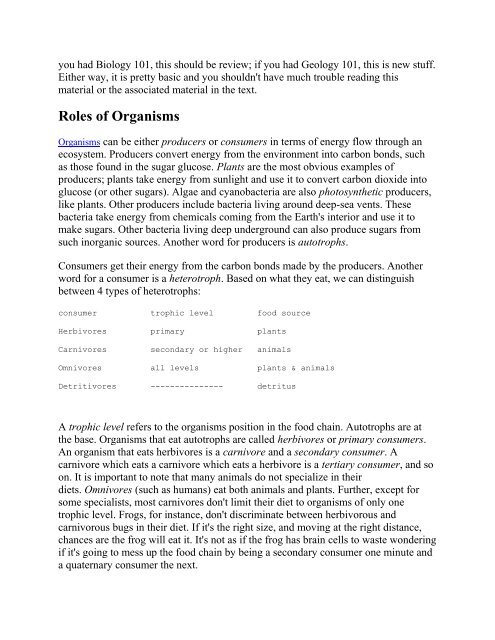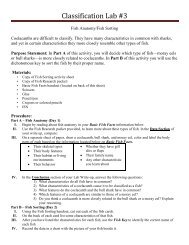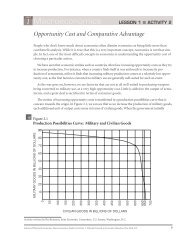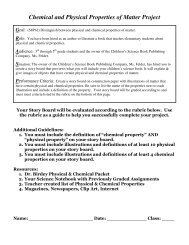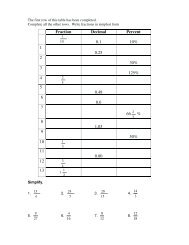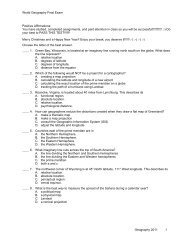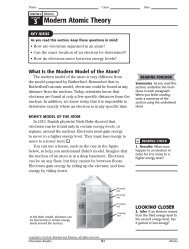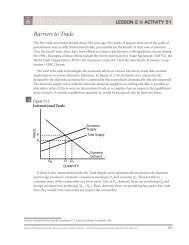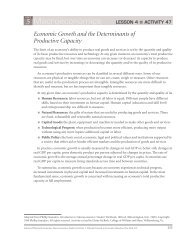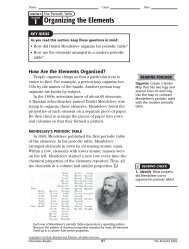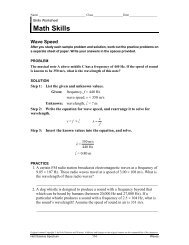Notes on Biogeochemical Cycles and Ecology.pdf
Notes on Biogeochemical Cycles and Ecology.pdf
Notes on Biogeochemical Cycles and Ecology.pdf
You also want an ePaper? Increase the reach of your titles
YUMPU automatically turns print PDFs into web optimized ePapers that Google loves.
you had Biology 101, this should be review; if you had Geology 101, this is new stuff.Either way, it is pretty basic <strong>and</strong> you shouldn't have much trouble reading thismaterial or the associated material in the text.Roles of OrganismsOrganisms can be either producers or c<strong>on</strong>sumers in terms of energy flow through anecosystem. Producers c<strong>on</strong>vert energy from the envir<strong>on</strong>ment into carb<strong>on</strong> b<strong>on</strong>ds, suchas those found in the sugar glucose. Plants are the most obvious examples ofproducers; plants take energy from sunlight <strong>and</strong> use it to c<strong>on</strong>vert carb<strong>on</strong> dioxide intoglucose (or other sugars). Algae <strong>and</strong> cyanobacteria are also photosynthetic producers,like plants. Other producers include bacteria living around deep-sea vents. Thesebacteria take energy from chemicals coming from the Earth's interior <strong>and</strong> use it tomake sugars. Other bacteria living deep underground can also produce sugars fromsuch inorganic sources. Another word for producers is autotrophs.C<strong>on</strong>sumers get their energy from the carb<strong>on</strong> b<strong>on</strong>ds made by the producers. Anotherword for a c<strong>on</strong>sumer is a heterotroph. Based <strong>on</strong> what they eat, we can distinguishbetween 4 types of heterotrophs:c<strong>on</strong>sumer trophic level food sourceHerbivores primary plantsCarnivores sec<strong>on</strong>dary or higher animalsOmnivores all levels plants & animalsDetritivores --------------- detritusA trophic level refers to the organisms positi<strong>on</strong> in the food chain. Autotrophs are atthe base. Organisms that eat autotrophs are called herbivores or primary c<strong>on</strong>sumers.An organism that eats herbivores is a carnivore <strong>and</strong> a sec<strong>on</strong>dary c<strong>on</strong>sumer. Acarnivore which eats a carnivore which eats a herbivore is a tertiary c<strong>on</strong>sumer, <strong>and</strong> so<strong>on</strong>. It is important to note that many animals do not specialize in theirdiets. Omnivores (such as humans) eat both animals <strong>and</strong> plants. Further, except forsome specialists, most carnivores d<strong>on</strong>'t limit their diet to organisms of <strong>on</strong>ly <strong>on</strong>etrophic level. Frogs, for instance, d<strong>on</strong>'t discriminate between herbivorous <strong>and</strong>carnivorous bugs in their diet. If it's the right size, <strong>and</strong> moving at the right distance,chances are the frog will eat it. It's not as if the frog has brain cells to waste w<strong>on</strong>deringif it's going to mess up the food chain by being a sec<strong>on</strong>dary c<strong>on</strong>sumer <strong>on</strong>e minute <strong>and</strong>a quaternary c<strong>on</strong>sumer the next.


